Practicing the Bridges in Mathematics Grade 4 Student Book Answer Key Unit 7 Module 1 will help students analyze their level of preparation.
Bridges in Mathematics Grade 4 Student Book Answer Key Unit 7 Module 1
Bridges in Mathematics Grade 4 Student Book Unit 7 Module 1 Session 1 Answer Key
Multiplication Review
Question 1.
Solve.
3 × 8 = _____________
6 × 10 = _____________
12 × _____________ = 60
_____________ = 8 × 4
12 × _____________ = 36
_____________ = 3 × 4
4 × 6 = _____________
8 × _____________ = 48
6 × 3 = _____________
12 × 4 = _____________
10 × _____________ = 120
12 × 40 = _____________
Answer:
We have multiplied
3 × 8 = 24
6 × 10 = 60
12 × 5 = 60
32 = 8 × 4
12 × 3 = 36
12 = 3 × 4
4 × 6 = 24
8 × 6 = 48
6 × 3 = 12
12 × 4 = 48
10 × 12 = 120
12 × 40 = 480
Question 2.
Multiply. Show your work. You can use the problems you solved above to help.
40 × 36 = _____________
43 × 12 = _____________
Answer:
40 × 36 = 1440.
43 × 12 = 516.
Explanation:
The multiplication of 40 × 36 is 1440.
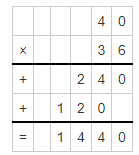
The multiplication of 43 × 12 is 516.

Question 3.
This table is about the cost of apples. Fill in the missing numbers in the table.
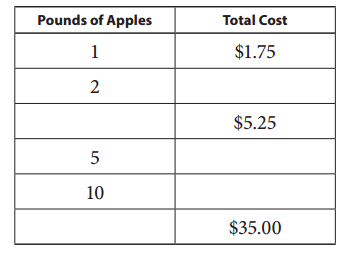
Answer:
2×$1.75 = $3.5,
$5.25 ÷ $1.75 = 3,
5×$1.75 = $8.75,
10×$1.75 = $17.5,
$35.00 ÷ $1.75 = 20.
Explanation:
The missing numbers are
2×$1.75 = $3.5,
$5.25 ÷ $1.75 = 3,
5×$1.75 = $8.75,
10×$1.75 = $17.5,
$35.00 ÷ $1.75 = 20.

Question 4.
CHALLENGE Use numbers, tables, sketches, or words to solve the problems below.
a. How many pounds of apples can you get for $70?
Answer:
We can get 40 pounds of apples.
Explanation:
We can get $70÷$1.75 which is 40 pounds of apples.
b. How much do you have to pay for 15 pounds of apples?
Answer:
We need to pay $26.25.
Explanation:
We need to pay 15×$1.75 which is $26.25 for 15 pounds of apples.
Bridges in Mathematics Grade 4 Student Book Unit 7 Module 1 Session 2 Answer Key
Fraction Mixer Card
My fraction: __________________
Fractions less than my fraction: __________________
Fractions equal to my fraction: __________________
Fractions greater than my fraction: __________________
CHALLENGE A fraction that makes 1 when I add it to mine: __________________
What I learned or noticed today about comparing fractions: __________________
Answer:
Here, the fraction we took is \(\frac{1}{2}\),
Fractions less than my fraction is \(\frac{1}{3}\), \(\frac{1}{4}\), \(\frac{1}{5}\),
Fractions equal to my fraction is \(\frac{2}{4}\), \(\frac{3}{6}\), \(\frac{4}{8}\),
Fractions greater than my fraction is \(\frac{2}{3}\), \(\frac{3}{4}\), \(\frac{4}{5}\),
fraction that makes 1 when I add it to mine is \(\frac{1}{2}\) which is \(\frac{1}{2}\)+\(\frac{1}{2}\)
= 1.
By comparing fractions we can see same numerators are same mostly which makes easy to compare and we need to add same fraction to get the 1.
Shading & Comparing Fractions
Question 1.
Shade in a bar below to show each fraction. Write the fraction you shaded beside each bar.
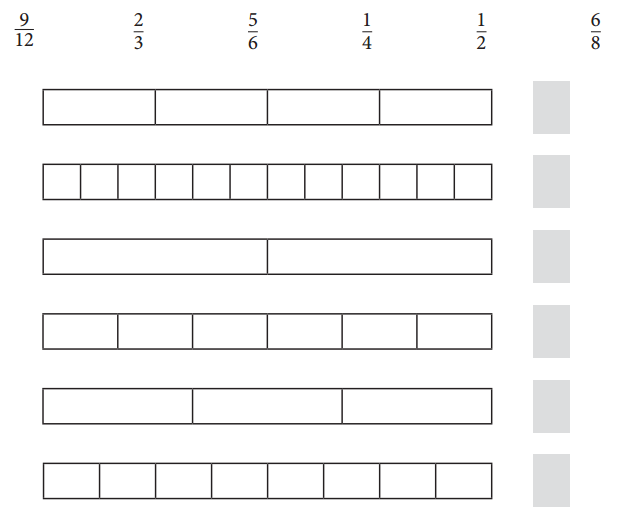
Answer:

Explanation:
Here, we have shaded in a bar below to show each fraction and written the fraction we have shaded beside each bar.
Question 2.
Which fraction above is the greatest, and which is the least? Write a comparison statement using < or > to show.
Answer:
\(\frac{5}{6}\) > \(\frac{1}{4}\) or \(\frac{1}{4}\) < \(\frac{5}{6}\).
Explanation:
The fractions that are greatest and least are
\(\frac{5}{6}\) > \(\frac{1}{4}\) or \(\frac{1}{4}\) < \(\frac{5}{6}\).
Question 3.
Which two fractions above are equivalent fractions? Explain how you know.
Answer:
\(\frac{9}{12}\) and \(\frac{6}{8}\).
Explanation:
The two fractions that are equivalent are \(\frac{9}{12}\) and \(\frac{6}{8}\) because we can see that the amount of shaded part on two bars are exactly equal.
Bridges in Mathematics Grade 4 Student Book Unit 7 Module 1 Session 3 Answer Key
Lining Up Fractions
Question 1.
Label each unlabeled mark on the number line below. You will be able to label some of them with more than one fraction.

Answer:

Explanation:
Here, we have labeled each unlabeled mark on the number line.
Question 2.
What fraction is equivalent to \(\frac{1}{4}\)?____________
Answer:
\(\frac{2}{8}\) and \(\frac{3}{12}\).
Explanation:
The equivalent fractions to \(\frac{1}{4}\) is \(\frac{2}{8}\) and \(\frac{3}{12}\).
Question 3.
Name three more pairs of equivalent fractions you see on the number line.
___________ = ___________
___________ = ___________
___________ = ___________
Answer:
\(\frac{2}{4}\) = \(\frac{4}{8}\),
\(\frac{2}{3}\) = \(\frac{4}{6}\) ,
\(\frac{5}{6}\) = \(\frac{10}{12}\) .
Explanation:
The three pairs of equivalent fractions are
\(\frac{2}{4}\) = \(\frac{4}{8}\),
\(\frac{2}{3}\) = \(\frac{4}{6}\) ,
\(\frac{5}{6}\) = \(\frac{10}{12}\) .
Question 4.
a. Which fraction is closer to 1: \(\frac{11}{12}\) or \(\frac{7}{8}\)? ______________
Answer:
\(\frac{7}{8}\) is closer to 1 than \(\frac{11}{12}\).
Explanation:
To know which fraction is closer to 1 we will subtract each fraction from 1 and we will compare, so
= 1 – \(\frac{11}{12}\)
= \(\frac{12-11}{12}\)
= \(\frac{1}{12}\)
and
= 1 – \(\frac{7}{8}\)
= \(\frac{8-7}{8}\)
= \(\frac{1}{8}\)
As \(\frac{1}{8}\) is smaller than \(\frac{1}{12}\) we can conclude that \(\frac{7}{8}\) is closer to 1 than \(\frac{11}{12}\).
b. Write an inequality statement to compare \(\frac{11}{12}\) and \(\frac{7}{8}\) using < or >. _______________
Answer:
\(\frac{11}{12}\) > \(\frac{7}{8}\).
Explanation:
Here, we will subtract one fraction from other and then we will compare with 0. So
= \(\frac{11}{12}\) – \(\frac{7}{8}\)
= \(\frac{22-21}{24}\)
= \(\frac{1}{24}\) which is greater than 0.
As inequality is true, so
\(\frac{11}{12}\) > \(\frac{7}{8}\).
Question 5.
a. Which fraction is closer to \(\frac{1}{2}\): \(\frac{5}{12}\) or \(\frac{3}{8}\)? ____________
Answer:
\(\frac{3}{8}\) is closer to \(\frac{1}{2}\).
Explanation:
Here, we will subtract \(\frac{1}{2}\) from \(\frac{5}{12}\) and \(\frac{3}{8}\) to know which fraction is closer. So
= \(\frac{5}{12}\) – \(\frac{1}{2}\)
= \(\frac{5-6}{12}\)
= \(\frac{1}{12}\)
and
= \(\frac{3}{8\) – \(\frac{1}{2}\)
= \(\frac{3-4}{8}\)
= \(\frac{1}{8}\) is smaller than \(\frac{1}{12}\) we can conclude that is smaller than \(\frac{3}{8}\) is closer to \(\frac{1}{2}\).
b. Write an inequality statement to compare \(\frac{5}{12}\) and \(\frac{3}{8}\) using < or >. _____________
Answer:
\(\frac{5}{12}\) > \(\frac{3}{8}\).
Explanation:
Here, we will subtract one fraction from other and then we will compare with 0. So
= \(\frac{5}{12}\) – \(\frac{3}{8}\)
= \(\frac{10-9}{24}\)
= \(\frac{1}{24}\) which is greater than 0.
As inequality is true, so
\(\frac{5}{12}\) > \(\frac{3}{8}\).
Question 6.
a. Which is greater: \(\frac{1}{3}\) or \(\frac{3}{8}\)? ____________
Answer:
\(\frac{3}{8}\) is greater than \(\frac{1}{3}\).
Explanation:
To know which fraction is greater, we will convert both the fractions to have common denominators and then we will compare the numerator. So
\(\frac{1}{3}\) × \(\frac{1}{8}\)
= \(\frac{1}{24}\)
and
\(\frac{3}{8}\) × \(\frac{1}{3}\)
= \(\frac{3}{24}\).
By comparing \(\frac{3}{8}\) is greater than \(\frac{1}{3}\).
b. Explain how you know.
Answer:
Here, we have converted both the fractions to have common denominators and then we compared the numerator to know which fraction is greater.
Shading & Comparing Fractions Using Half
This bar shows \(\frac{1}{2}\).

Question 1.
Shade in some of each bar below to show four fractions. Make them so that no two of your fractions are equivalent to each other.
Answer:

Explanation:
We have shaded in some of each bar below to show four fractions.
Question 2.
Next to each bar, write the fraction that describes your work, then use <, =, or > to show how the fraction you shaded compares to \(\frac{1}{2}\).
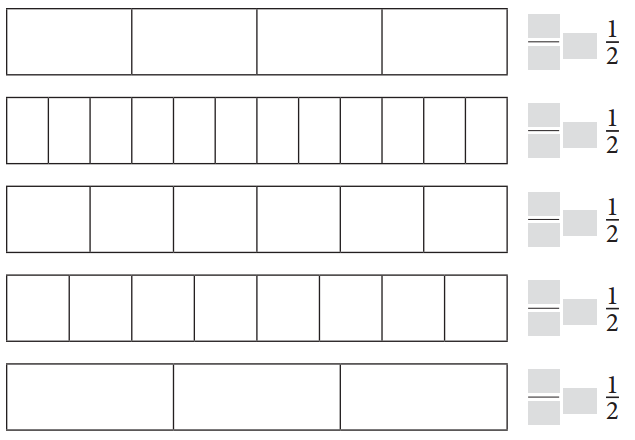
Answer:
Here, we have shaded and compared the shaded portion with \(\frac{1}{2}\).

Question 3.
Write your five fractions in order from least to greatest.
__________ __________ __________ __________ __________
Answer:
\(\frac{1}{4}\)<\(\frac{1}{3}\)<\(\frac{2}{5}\)<\(\frac{1}{2}\)<\(\frac{2}{3}\).
Explanation:
The fractions are \(\frac{1}{3}\), \(\frac{1}{4}\), \(\frac{2}{5}\), \(\frac{2}{3}\), \(\frac{1}{2}\). Here, we will make the denominators common and then we will order from least to greatest. So lcm for 2,3,4,5 is 60.
\(\frac{1}{3}\) × \(\frac{20}{20}\) = \(\frac{20}{60}\),
\(\frac{1}{4}\) × \(\frac{15}{15}\) = \(\frac{15}{60}\),
\(\frac{2}{5}\) × \(\frac{12}{12}\) = \(\frac{24}{60}\),
\(\frac{2}{3}\) × \(\frac{20}{20}\) = \(\frac{40}{60}\),
\(\frac{1}{2}\) × \(\frac{30}{30}\) = \(\frac{30}{60}\),
The fractions from least to greatest is
\(\frac{1}{4}\)<\(\frac{1}{3}\)<\(\frac{2}{5}\)<\(\frac{1}{2}\)<\(\frac{2}{3}\).
Bridges in Mathematics Grade 4 Student Book Unit 7 Module 1 Session 4 Answer Key
Equivalent Fraction Fill Record Sheet 1
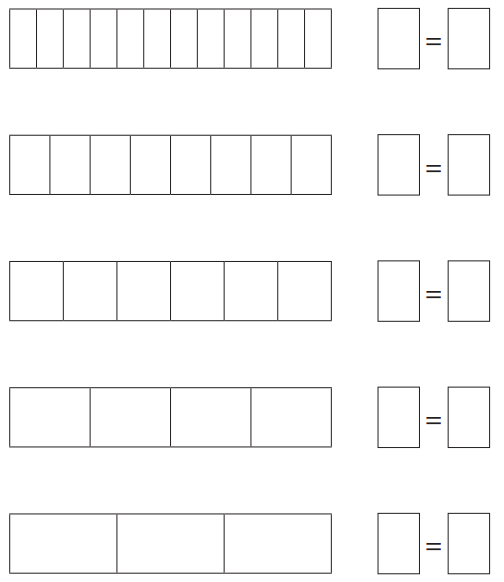
Answer:
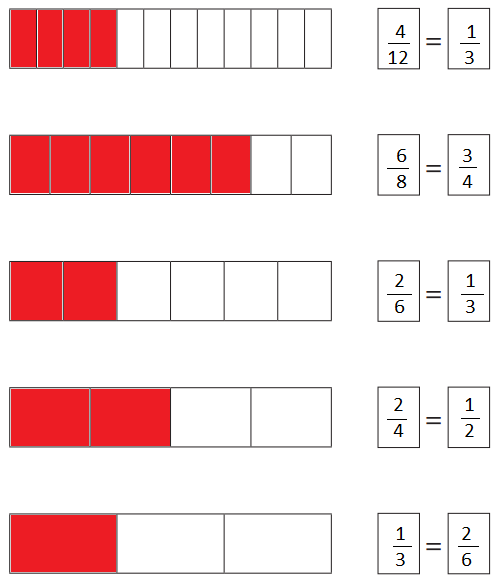
Explanation:
Here, we have shaded and wrote the equivalent fraction.
Equivalent Fraction Fill Record Sheet 2

Answer:

Explanation:
Here, we have shaded and wrote the equivalent fraction.
Equivalent Fraction Fill Experimentation Sheet
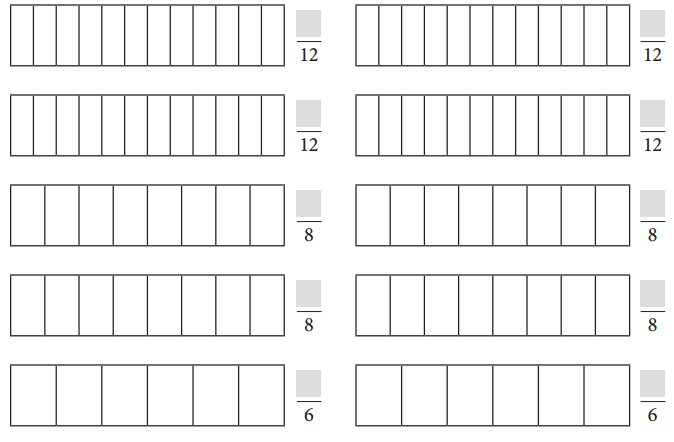
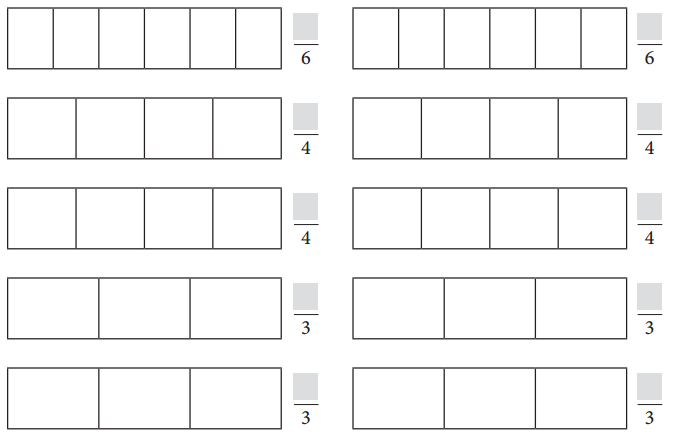
Answer:

Explanation:
We have done Equivalent Fraction Fill Experimentation Sheet.
Comparing Fractions
Question 1.
Represent each fraction on a bar. Then complete each statement with <, >, or = to compare the fractions.
a.

\(\frac{5}{6}\) _____________ \(\frac{2}{3}\)
Answer:
\(\frac{5}{6}\) greater than \(\frac{2}{3}\).
Explanation:
Here, we make denominators common and then we will compare
\(\frac{2}{3}\) × \(\frac{2}{2}\) = \(\frac{4}{6}\).
So by comparing \(\frac{5}{6}\) is greater than \(\frac{2}{3}\).

b.

\(\frac{2}{3}\) _____________ \(\frac{3}{8}\)
Answer:
\(\frac{2}{3}\) is greater than \(\frac{3}{8}\).
Explanation:
Here, we make denominators common and then we will compare
\(\frac{2}{3}\) × \(\frac{8}{8}\) = \(\frac{16}{24}\),
\(\frac{3}{8}\) × \(\frac{3}{3}\) = × \(\frac{9}{24}\)
So by comparing \(\frac{2}{3}\) is greater than \(\frac{3}{8}\).

c.
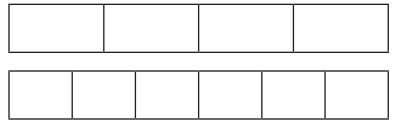
\(\frac{4}{6}\) _____________ \(\frac{3}{4}\)
Answer:
\(\frac{3}{4}\) is greater than \(\frac{4}{6}\).
Explanation:
Here, we make denominators common and then we will compare
\(\frac{4}{6}\) × \(\frac{4}{4}\) = \(\frac{16}{24}\),
\(\frac{3}{4}\) × \(\frac{6}{6}\) = \(\frac{18}{24}\)
So by comparing \(\frac{3}{4}\) is greater than \(\frac{4}{6}\).

Question 2.
a. Find two fractions above that are equivalent. Write them here.
_____________ = _____________
Answer:
\(\frac{4}{6}\) = \(\frac{2}{3}\).
Explanation:
The two equivalent fractions are \(\frac{4}{6}\) and \(\frac{2}{3}\).
b. Explain how you know the fractions are equivalent.
Answer:
We know that the fractions are equivalent as they have different numerators and denominators but with the same value.
Comparing Fractions with a Number Line
Use this number line to help you solve the problems and answer the questions below.
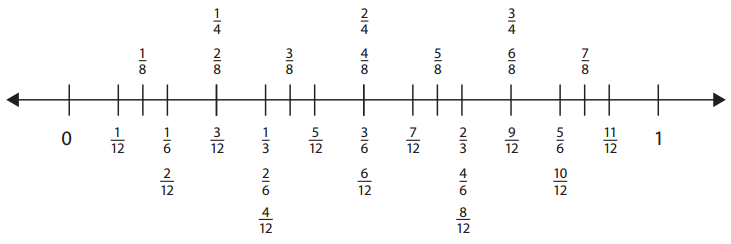
Question 1.
Use what you know about how each fraction compares to 1 to complete these comparisons with <, =, or >.
\(\frac{5}{6}\) ______________ \(\frac{11}{12}\)
\(\frac{5}{6}\) ______________ \(\frac{7}{8}\)
\(\frac{11}{12}\) ______________ \(\frac{7}{8}\)
\(\frac{7}{8}\) ______________ \(\frac{2}{3}\)
\(\frac{3}{4}\) ______________ \(\frac{5}{6}\)
Answer:
\(\frac{5}{6}\) < \(\frac{11}{12}\)
\(\frac{5}{6}\) < \(\frac{7}{8}\)
\(\frac{11}{12}\) > \(\frac{7}{8}\)
\(\frac{7}{8}\) > \(\frac{2}{3}\)
\(\frac{3}{4}\) < \(\frac{5}{6}\)
Explanation:
By using number line we can say that
\(\frac{5}{6}\) is less than \(\frac{11}{12}\)
\(\frac{5}{6}\) is less than \(\frac{7}{8}\)
\(\frac{11}{12}\) is greater than \(\frac{7}{8}\)
\(\frac{7}{8}\) is greater than \(\frac{2}{3}\)
\(\frac{3}{4}\) is less than \(\frac{5}{6}\)
Question 2.
Use what you know about how far each fraction is from 0 to complete these comparisons with <, =, or >.
\(\frac{1}{6}\) ______________ \(\frac{1}{12}\)
\(\frac{1}{6}\) ______________ \(\frac{3}{8}\)
\(\frac{1}{12}\) ______________ \(\frac{3}{8}\)
\(\frac{3}{8}\) ______________ \(\frac{1}{3}\)
\(\frac{1}{4}\) ______________ \(\frac{1}{6}\)
Answer:
\(\frac{1}{6}\) < \(\frac{1}{12}\)
\(\frac{1}{6}\) > \(\frac{3}{8}\)
\(\frac{1}{12}\) > \(\frac{3}{8}\)
\(\frac{3}{8}\) < \(\frac{1}{3}\)
\(\frac{1}{4}\) < \(\frac{1}{6}\)
Explanation:
By using number line we can say that
\(\frac{1}{6}\) greater than \(\frac{1}{12}\)
\(\frac{1}{6}\) less than \(\frac{3}{8}\)
\(\frac{1}{12}\) less than \(\frac{3}{8}\)
\(\frac{3}{8}\) greater than \(\frac{1}{3}\)
\(\frac{1}{4}\) greater than \(\frac{1}{6}\)
Question 3.
On this bar, shade in \(\frac{4}{6}\).

Answer:
We have shaded \(\frac{4}{6}\) part of the bar.

Question 4.
Use this bar to show how many thirds are equal to \(\frac{4}{6}\). Then write an equation to show.

Answer:
We have shaded \(\frac{2}{3}\) part of the bar and there are two thirds which is equivalent to \(\frac{4}{6}\).

Question 5.
Use this bar to show how many twelfths are equal to \(\frac{4}{6}\). Then write an equation to show.

Answer:
We have shaded \(\frac{8}{12}\) part of the bar and there are eight twelfths which is equivalent to \(\frac{4}{6}\).

Bridges in Mathematics Grade 4 Student Book Unit 7 Module 1 Session 5 Answer Key
Shade & Describe Equivalent Fractions
Question 1.
Use the bars below to draw and shade two fractions that are equivalent to \(\frac{2}{3}\). For each new fraction, write an expression to show how you multiplied both the numerator and the denominator to make the new fraction.

a.

Answer:
\(\frac{2}{3}\)× \(\frac{2}{2}\) = \(\frac{4}{6}\).
Explanation:
To get the new fraction we will multiply \(\frac{2}{3}\)× \(\frac{2}{2}\) which is \(\frac{4}{6}\)

b.

Answer:
\(\frac{2}{3}\)× \(\frac{3}{3}\) = \(\frac{6}{9}\).
Explanation:
To get the new fraction we will multiply \(\frac{2}{3}\)× \(\frac{3}{3}\) which is \(\frac{6}{9}\)

Question 2.
Use the bars below to draw and shade two fractions that are equivalent to \(\frac{3}{5}\). For each new fraction, write an expression to show how you multiplied both the numerator and the denominator to make the new fraction.

a.

Answer:
\(\frac{3}{5}\)× \(\frac{2}{2}\) = \(\frac{6}{10}\).
Explanation:
To get the new fraction we will multiply \(\frac{3}{5}\)× \(\frac{2}{2}\) which is \(\frac{6}{10}\)

b.

Answer:
\(\frac{3}{5}\)× \(\frac{3}{3}\) = \(\frac{9}{15}\).
Explanation:
To get the new fraction we will multiply \(\frac{3}{5}\)× \(\frac{3}{3}\) which is \(\frac{9}{15}\)

Question 3.
Which fraction is greater: \(\frac{2}{3}\) or \(\frac{3}{5}\)? How do you know?
Answer:
\(\frac{2}{3}\) is greater than \(\frac{3}{5}\).
Explanation:
To determine which fraction is we will find the LCM of 3 and 5 which is 15.
Now we will make denominators common, so
\(\frac{2}{3}\) × \(\frac{5}{5}\) = \(\frac{10}{15}\) and
\(\frac{3}{5}\) × \(\frac{3}{3}\) = \(\frac{9}{15}\).
\(\frac{10}{15}\) is greater than \(\frac{9}{15}\).
So \(\frac{2}{3}\) is greater than \(\frac{3}{5}\).
Bridges in Mathematics Grade 4 Student Book Unit 7 Module 1 Session 6 Answer Key
Comparing Fractions in Context
Brianna and her brother Corey love the kind of bubble gum that looks like a long roll of tape. The whole roll is way too much gum to chew at once, so their grandma cut two pieces that were exactly the same length and gave one to Brianna and one to Corey. Brianna cut her gum tape into 3 equal pieces and chewed 2 of them. Corey cut his gum tape into 5 equal pieces and chewed of them. Who chewed more gum?
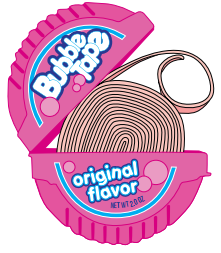
a. Brianna chewed _____________ of a strip. Corey chewed _____________ of a strip.
Answer:
Brianna chewed \(\frac{2}{3}\) of a strip.
Corey chewed \(\frac{4}{5}\) of a strip.
Explanation:
To compare these fractions, we need to find a common denominator. The smallest common multiple of 3 and 5 is 15.
\(\frac{2}{3}\) = \(\frac{10}{15}\)
\(\frac{4}{5}\)= \(\frac{12}{15}\)
Since \(\frac{12}{15}\) is greater than \(\frac{10}{15}\), Corey chewed more gum than Brianna.
Brianna chewed \(\frac{2}{3}\) of a strip.
Corey chewed \(\frac{4}{5}\) of a strip.
b. _____________ chewed more than _____________.
We know because _____________ _____________ _____________.
Answer:
Corey chewed more than Brianna.
Explanation:
Corey chewed more than Brianna.
We know because \(\frac{4}{5}\) > \(\frac{2}{3}\).
Question 2.
Their cousins Malik and Caitlin came over, so, to be fair, their grandma gave each of them a piece of gum tape that was exactly the same length. Malik chewed his and Caitlin chewed 10 of hers. Who chewed more: Malik or Caitlin?
a. _____________ chewed more than _____________.
We know because _____________ _____________ _____________.
Answer:
Caitlin chewed more gum tape than Malik.
We know this because Caitlin chewed 10 pieces of her gum tape.
Explanation:
We know this because Caitlin chewed 10 pieces of her gum tape, whereas Malik only chewed his single piece. Therefore, Caitlin chewed more than Malik.
Caitlin chewed more gum tape than Malik.
Question 3.
Later that day, Brianna and Corey left their grandma’s house and went home. Their dad gave them some fruit leather in long strips as a snack. Brianna and Corey each got their own strip, and the strips were exactly the same length. Brianna cut her strip into 5 equal pieces and ate 3 of them. Corey cut his strip into 8 equal pieces and ate 5 of them. Who ate a greater amount of fruit leather, Brianna or Corey?
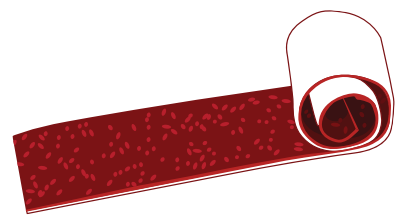
a. Brianna ate ____________ of a fruit leather strip.
Corey ate ____________ of a fruit leather strip.
Answer:
Brianna ate \(\frac{3}{5}\) of a fruit leather strip, and Corey ate \(\frac{5}{8}\) of a fruit leather strip.
Explanation:
To determine who ate a greater amount, we need to compare the fractions. So let’s find a common denominator for 5 and 8, which is 40.
Brianna’s portion can be expressed as \(\frac{3}{5}\)× \(\frac{8}{8}\) =\(\frac{24}{40}\) of a fruit leather strip.
Corey’s portion can be expressed as \(\frac{5}{8}\)× \(\frac{5}{5}\) =\(\frac{25}{40}\) of a fruit leather strip.
Brianna ate \(\frac{3}{5}\) of a fruit leather strip, and Corey ate \(\frac{5}{8}\) of a fruit leather strip.
Comparing the fractions, we can see that Corey ate a greater amount of fruit leather.
b. ___________ ate more than _______________.
We know because _____________ _____________ _____________.
Answer:
Corey ate more than Brianna.
We know because Corey ate more than Brianna.
Explanation:
We know this because Corey ate \(\frac{25}{40}\) of a fruit leather strip, while Brianna ate \(\frac{24}{40}\) of a fruit leather strip. Therefore, Corey ate more than Brianna.
Comparing Fractions with Different Denominators
Question 1.
Rewrite each fraction with the denominator 24.
ex:
\(\frac{1}{2}\) × \(\frac{12}{12}\) = \(\frac{12}{24}\)
a. \(\frac{1}{3}\)
Answer:
\(\frac{8}{24}\)
Explanation:
To rewrite the fraction \(\frac{1}{3}\) with the denominator 24, we can multiply the numerator and denominator by 8
\(\frac{1}{3}\) × \(\frac{8}{8}\) = \(\frac{8}{24}\)
b. \(\frac{2}{3}\)
Answer:
\(\frac{6}{24}\)
Explanation:
To rewrite the fraction \(\frac{2}{3}\) with the denominator 24, we can multiply the numerator and denominator by 8
\(\frac{2}{3}\) × \(\frac{8}{8}\) = \(\frac{6}{24}\)
c. \(\frac{1}{4}\)
Answer:
\(\frac{6}{24}\)
Explanation:
To rewrite the fraction \(\frac{1}{4}\) with the denominator 24, we can multiply the numerator and denominator by 6
\(\frac{1}{4}\) × \(\frac{6}{6}\) = \(\frac{6}{24}\)
d. \(\frac{3}{4}\)
Answer:
\(\frac{18}{24}\)
Explanation:
To rewrite the fraction \(\frac{3}{4}\) with the denominator 24, we can multiply the numerator and denominator by 6
\(\frac{3}{4}\) × \(\frac{6}{6}\) = \(\frac{18}{24}\)
e. \(\frac{1}{6}\)
Answer:
\(\frac{4}{24}\)
Explanation:
To rewrite the fraction \(\frac{1}{6}\) with the denominator 24, we can multiply the numerator and denominator by 4
\(\frac{1}{6}\) × \(\frac{4}{4}\) = \(\frac{4}{24}\)
f. \(\frac{5}{6}\)
Answer:
\(\frac{20}{24}\)
Explanation:
To rewrite the fraction \(\frac{5}{6}\) with the denominator 24, we can multiply the numerator and denominator by 4
\(\frac{5}{6}\) × \(\frac{4}{4}\) = \(\frac{20}{24}\)
g. \(\frac{3}{8}\)
Answer:
\(\frac{9}{24}\)
Explanation:
To rewrite the fraction \(\frac{3}{8}\) with the denominator 24, we can multiply the numerator and denominator by 3
\(\frac{3}{8}\) × \(\frac{3}{3}\) = \(\frac{9}{24}\)
h. \(\frac{5}{8}\)
Answer:
\(\frac{15}{24}\)
Explanation:
To rewrite the fraction \(\frac{5}{8}\) with the denominator 24, we can multiply the numerator and denominator by 3
\(\frac{5}{8}\) × \(\frac{3}{3}\) = \(\frac{15}{24}\)
i. \(\frac{5}{12}\)
Answer:
\(\frac{10}{24}\)
Explanation:
To rewrite the fraction \(\frac{5}{12}\) with the denominator 24, we can multiply the numerator and denominator by 2
\(\frac{5}{12}\) × \(\frac{2}{2}\) = \(\frac{10}{24}\)
j. \(\frac{7}{12}\)
Answer:
\(\frac{14}{24}\)
Explanation:
To rewrite the fraction \(\frac{7}{12}\) with the denominator 24, we can multiply the numerator and denominator by 2
\(\frac{7}{12}\) × \(\frac{2}{2}\) = \(\frac{14}{24}\)
Question 2.
Rewrite each pair of fractions with a common denominator. Then write an inequality to compare them.
ex: \(\frac{1}{3}\) \(\frac{5}{12}\)
\(\frac{8}{24}\) \(\frac{10}{24}\)
\(\frac{1}{3}\) < \(\frac{5}{12}\)
a. \(\frac{2}{3}\) \(\frac{5}{8}\)
Answer:
\(\frac{2}{3}\) is greater than \(\frac{5}{8}\).
Explanation:
To rewrite the fractions \(\frac{2}{3}\) and \(\frac{5}{8}\) with a common denominator, we can find the least common multiple (LCM) of 3 and 8, which is 24.
\(\frac{2}{3}\) × \(\frac{8}{8}\) = \(\frac{16}{24}\)
\(\frac{5}{8}\) × \(\frac{3}{3}\) = \(\frac{15}{24}\)
Now, let’s compare the fractions using an inequality:
\(\frac{16}{24}\) > \(\frac{15}{24}\)
Therefore, \(\frac{2}{3}\) is greater than \(\frac{5}{8}\).
b. \(\frac{5}{12}\) \(\frac{3}{4}\)
Answer:
\(\frac{5}{12}\) is less than \(\frac{3}{4}\).
Explanation:
To rewrite the fractions \(\frac{5}{12}\) and \(\frac{3}{4}\) with a common denominator, we can find the least common multiple (LCM) of 12 and 4, which is 12.
\(\frac{5}{12}\) × \(\frac{1}{1}\) = \(\frac{5}{12}\)
\(\frac{3}{4}\) × \(\frac{3}{3}\) = \(\frac{9}{12}\)
Now, let’s compare the fractions using an inequality:
\(\frac{5}{12}\) < \(\frac{9}{12}\)
Therefore, \(\frac{5}{12}\) is less than \(\frac{3}{4}\).
c. \(\frac{3}{8}\) \(\frac{1}{3}\)
Answer:
\(\frac{9}{24}\) is greater than \(\frac{8}{24}\).
Explanation:
To rewrite the fractions \(\frac{3}{8}\) and \(\frac{1}{3}\) with a common denominator, we can find the least common multiple (LCM) of 8 and 3, which is 24.
\(\frac{3}{8}\) × \(\frac{3}{3}\) = \(\frac{9}{24}\)
\(\frac{1}{3}\) × \(\frac{8}{8}\) = \(\frac{8}{24}\)
Now, let’s compare the fractions using an inequality:
\(\frac{9}{24}\) > \(\frac{8}{24}\)
Therefore, \(\frac{9}{24}\) is greater than \(\frac{8}{24}\).
d. \(\frac{1}{3}\) \(\frac{2}{5}\)
Answer:
\(\frac{1}{3}\) is less than \(\frac{2}{5}\).
Explanation:
To rewrite the fractions \(\frac{1}{3}\) and \(\frac{2}{5}\) with a common denominator, we can find the least common multiple (LCM) of 3 and 5, which is 15.
\(\frac{1}{3}\) × \(\frac{5}{5}\) = \(\frac{5}{15}\)
\(\frac{2}{5}\) × \(\frac{3}{3}\) = \(\frac{6}{15}\)
Now, let’s compare the fractions using an inequality:
\(\frac{5}{15}\) < \(\frac{6}{15}\)
Therefore, \(\frac{1}{3}\) is less than \(\frac{2}{5}\).
e. \(\frac{7}{12}\) \(\frac{6}{8}\)
Answer:
\(\frac{7}{12}\) is less than \(\frac{6}{8}\).
Explanation:
To rewrite the fractions \(\frac{7}{12}\) and \(\frac{6}{8}\) with a common denominator, we can find the least common multiple (LCM) of 12 and 8, which is 24.
\(\frac{7}{12}\) × \(\frac{2}{2}\) = \(\frac{14}{24}\)
\(\frac{6}{8}\) × \(\frac{3}{3}\) = \(\frac{18}{24}\)
Now, let’s compare the fractions using an inequality:
\(\frac{14}{24}\) < \(\frac{18}{24}\)
Therefore, \(\frac{7}{12}\) is less than \(\frac{6}{8}\).
f. \(\frac{5}{8}\) \(\frac{7}{10}\)
Answer:
\(\frac{5}{8}\) is less than \(\frac{7}{10}\).
Explanation:
To rewrite the fractions \(\frac{5}{8}\) and \(\frac{7}{10}\) with a common denominator, we can find the least common multiple (LCM) of 8 and 10, which is 40.
\(\frac{5}{8}\) × \(\frac{5}{5}\) = \(\frac{25}{40}\)
\(\frac{7}{10}\) × \(\frac{4}{4}\) = \(\frac{28}{40}\)
Now, let’s compare the fractions using an inequality:
\(\frac{25}{40}\) < \(\frac{28}{40}\)
Therefore, \(\frac{5}{8}\) is less than \(\frac{7}{10}\).
g. \(\frac{5}{6}\) \(\frac{7}{8}\)
Answer:
\(\frac{5}{6}\) is greater than \(\frac{7}{8}\).
Explanation:
To rewrite the fractions \(\frac{5}{6}\) and \(\frac{7}{8}\) with a common denominator, we can find the least common multiple (LCM) of 6 and 8, which is 24.
\(\frac{5}{6}\) × \(\frac{4}{4}\) = \(\frac{20}{24}\)
\(\frac{7}{8}\) × \(\frac{3}{3}\) = \(\frac{21}{24}\)
Now, let’s compare the fractions using an inequality:
\(\frac{20}{24}\) < \(\frac{21}{24}\)
Therefore, \(\frac{5}{6}\) is greater than \(\frac{7}{8}\).
CHALLENGE
h. \(\frac{2}{3}\) \(\frac{5}{7}\)
Answer:
\(\frac{2}{3}\) is less than \(\frac{5}{7}\).
Explanation:
To rewrite the fractions \(\frac{2}{3}\) and \(\frac{5}{7}\) with a common denominator, we can find the least common multiple (LCM) of 3 and 7, which is 21.
\(\frac{2}{3}\) × \(\frac{7}{7}\) = \(\frac{14}{21}\)
\(\frac{5}{7}\) × \(\frac{3}{3}\) = \(\frac{15}{21}\)
Now, let’s compare the fractions using an inequality:
\(\frac{14}{21}\) < \(\frac{15}{21}\)
Therefore, \(\frac{2}{3}\) is less than \(\frac{5}{7}\).
i. \(\frac{7}{9}\) \(\frac{2}{3}\)
Answer:
\(\frac{7}{9}\) is greater than \(\frac{2}{3}\).
Explanation:
To rewrite the fractions \(\frac{7}{9}\) and \(\frac{2}{3}\) with a common denominator, we can find the least common multiple (LCM) of 9 and 3, which is 9.
\(\frac{7}{9}\) × \(\frac{1}{1}\) = \(\frac{7}{9}\)
\(\frac{2}{3}\) × \(\frac{3}{3}\) = \(\frac{6}{9}\)
Now, let’s compare the fractions using an inequality:
\(\frac{7}{9}\) > \(\frac{6}{9}\)
Therefore, \(\frac{7}{9}\) is greater than \(\frac{2}{3}\).
j. \(\frac{2}{5}\) \(\frac{3}{7}\)
Answer:
\(\frac{2}{5}\) is less than \(\frac{3}{7}\).
Explanation:
To rewrite the fractions \(\frac{2}{5}\) and \(\frac{3}{7}\) with a common denominator, we can find the least common multiple (LCM) of 5 and 7, which is 35.
\(\frac{2}{5}\) × \(\frac{7}{7}\) = \(\frac{14}{35}\)
\(\frac{3}{7}\) × \(\frac{5}{5}\) = \(\frac{15}{35}\)
Now, let’s compare the fractions using an inequality:
\(\frac{14}{35}\) < \(\frac{15}{35}\)
Therefore, \(\frac{2}{5}\) is less than \(\frac{3}{7}\).
Comparing Fractions at the Wild Animal Park
Jazmin and Brent visited a wild animal park. In most of the park, you look at the animals from a distance that is safe for both people and animals, but in one part of the park it’s OK to get close and feed some animals. You can buy seed bars to give to the prairie dogs, and little bricks of hay to feed to the deer.
Solve the problems below. You can use the fraction bars to help.
Question 1.
Brent and Jazmin each bought a seed bar to feed the prairie dogs. When they were done walking through the animal feeding area, Brent had \(\frac{3}{8}\) of his seed bar left. Jazmin had \(\frac{2}{5}\) of her seed bar left. Who had more of a seed bar left over?

______________ had more seed bar left over.
Answer:
Jazmin had more of a seed bar left over than Brent.
Explanation:
To compare the amount of seed bar left over between Brent and Jazmin, we need to compare the fractions \(\frac{3}{8}\) and \(\frac{2}{5}\).
To find a common denominator, we can multiply 8 and 5, which gives us 40.
Brent had \(\frac{3}{8}\) of his seed bar left, which can be rewritten as \(\frac{3}{8}\) × \(\frac{5}{5}\) =\(\frac{15}{40}\).
Jazmin had \(\frac{2}{5}\) of her seed bar left, which can be rewritten as \(\frac{2}{5}\) × \(\frac{8}{8}\) =\(\frac{16}{40}\).
Comparing the fractions, we can see that \(\frac{16}{40}\) is greater than \(\frac{15}{40}\).
Therefore, Jazmin had more of a seed bar left over than Brent.

Question 2.
a. Brent and Jazmin each bought a little brick of hay to feed to the deer. Brent fed \(\frac{5}{6}\) of his hay to the deer. Jazmin fed \(\frac{6}{8}\) of her hay to the deer. Who fed more hay to the deer?

_______________ fed more hay to the deer.
Answer:
Brent fed more hay to the deer than Jazmin.
Explanation:
To find a common denominator, we can multiply 6 and 8, which gives us 48.
Brent fed \(\frac{5}{6}\) of his hay to the deer, which can be rewritten as \(\frac{5}{6}\) × \(\frac{8}{8}\) =\(\frac{40}{48}\).
Jazmin fed \(\frac{6}{8}\) of her hay to the deer, which can be rewritten as \(\frac{6}{8}\) × \(\frac{6}{6}\) =\(\frac{36}{48}\).
Comparing the fractions, we can see that \(\frac{40}{48}\) is greater than \(\frac{36}{48}\).
Therefore, Brent fed more hay to the deer than Jazmin.

b. CHALLENGE Who had more hay left over, and how much did they have left?
______________ had ![]() of a brick of hay left over.
of a brick of hay left over.
Answer:
Brent had \(\frac{1}{6}\) of a brick of hay left over.
Explanation:
To determine who had more hay left over, we can subtract the fraction of hay fed from 1
Here, Brent fed \(\frac{5}{6}\) of his hay to the deer. Therefore, he had 1 – \(\frac{5}{6}\) left.
Using a common denominator of 6, we can rewrite this as \(\frac{6}{6}\) – \(\frac{5}{6}\) = \(\frac{1}{6}\).
Jazmin fed \(\frac{6}{8}\) of her hay to the deer. Therefore, she had 1 – \(\frac{6}{8}\) left.
Using a common denominator of 8, we can rewrite this as \(\frac{8}{8}\) – \(\frac{6}{8}\) = \(\frac{2}{8}\).
Simplifying the fractions, we have \(\frac{1}{6}\) of a hay brick left for Brent and \(\frac{1}{4}\) of a hay brick left for Jazmin.
Therefore, Brent had more hay left over, with \(\frac{1}{6}\) of a hay brick remaining, while Jazmin had \(\frac{1}{4}\) of a hay brick remaining.
Bridges in Mathematics Grade 4 Student Book Unit 7 Module 1 Session 7 Answer Key
Shade & Describe More Equivalent Fractions
Question 1.
a. Use the bars to show and name two fractions that are equivalent to \(\frac{8}{12}\). The denominators for two fractions you can make are filled in for you.
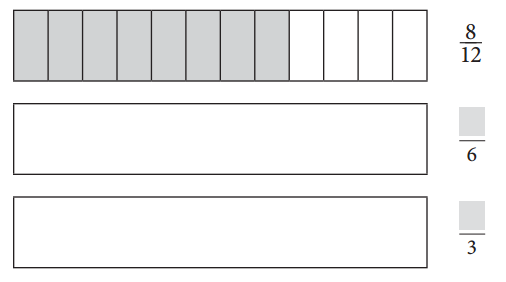
Answer:
The equivalent fractions for \(\frac{8}{12}\) is \(\frac{4}{6}\) and \(\frac{2}{3}\).
Explanation:
The equivalent fractions for \(\frac{8}{12}\) is \(\frac{4}{6}\) and \(\frac{2}{3}\). We have shaded the given bars.

b. How many sixths are equal to \(\frac{4}{12}\)? Write an equation to show.

Answer:
The number of sixths will be 2.
Explanation:
Here, \(\frac{4}{12}\) can be represented as \(\frac{1}{3}\). So the number of sixths that are equal to \(\frac{4}{12}\) will be 2. As \(\frac{1}{3}\) × \(\frac{2}{2}\) is \(\frac{2}{6}\).

c. How many thirds are equal to \(\frac{2}{6}\)? Write an equation to show.

Answer:
The number of thirds will be 1.
Explanation:
Here, \(\frac{2}{6}\) can be represented as \(\frac{1}{3}\). So the number of thirds that are equal to \(\frac{2}{6}\) will be 1.

Question 2.
a. Shade in this bar to show \(\frac{2}{5}\).

Answer:
We have shaded 2 parts of the bar.

b. Use this bar to show and name a fraction that is equivalent to \(\frac{2}{5}\). The bar has been divided into fifths for you. Draw more lines to make your equivalent fraction.

Answer:
\(\frac{2}{5}\) = \(\frac{4}{10}\).
Explanation:
The equivalent fraction of \(\frac{2}{5}\) is \(\frac{2}{5}\) × \(\frac{2}{2}\) which is × \(\frac{4}{10}\).

Question 3.
Which fraction is greater: \(\frac{8}{12}\) or \(\frac{2}{5}\)? How do you know?
Answer:
\(\frac{8}{12}\) is greater than \(\frac{2}{5}\).
Explanation:
To compare the fractions \(\frac{8}{12}\) and \(\frac{2}{5}\), we can convert them to equivalent fractions with a common denominator and then compare the numerators.
To find a common denominator, we can use the least common multiple (LCM) of 12 and 5, which is 60.
For \(\frac{8}{12}\), we can rewrite it as \(\frac{8}{12}\) × \(\frac{5}{5}\) = \(\frac{40}{60}\).
For \(\frac{2}{5}\), we can rewrite it as \(\frac{2}{5}\) × \(\frac{12}{12}\) = \(\frac{24}{60}\).
Now, we can see that \(\frac{40}{60}\) is greater than \(\frac{24}{60}\) because the numerator of \(\frac{40}{60}\) is greater than the numerator of \(\frac{24}{60}\).
Therefore, \(\frac{8}{12}\) is greater than \(\frac{2}{5}\).